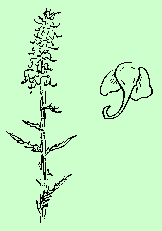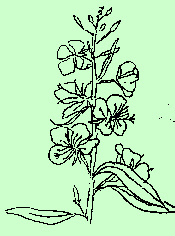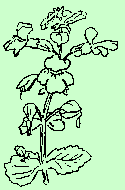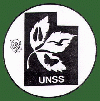|







|
. |
ALBION BASIN FIELD TRIPS
July 26, 1997
 As always, Albion Basin is one of the most beautiful flower gardens
anywhere. The peak of flowering would take more time, but there was
plenty to see. Hearing the white-crowned sparrow sing always touches me.
In spring, it takes me to high places. The Clark's Nutcracker's raucous
call rang out, and hummingbirds are beginning to search for nectar.
As always, Albion Basin is one of the most beautiful flower gardens
anywhere. The peak of flowering would take more time, but there was
plenty to see. Hearing the white-crowned sparrow sing always touches me.
In spring, it takes me to high places. The Clark's Nutcracker's raucous
call rang out, and hummingbirds are beginning to search for nectar.

Elephanthead
|

 After leaving Alta on the way up, we found along the road many bog orchids,
elephanthead, shooting stars, yellow monkey flowers, and the rare and
beautiful deep rose Lewis' monkey flower, the yellow columbine, mountain
sunflowers, and many more. On the drying hillsides the buckwheats were
just beginning, the feather gilia, and many of the strong-smelling mint,
pennyroyal. The round pinked leaves of the Brook Saxifrage and the
heart-leaf bittercress were seen along the edges of the small streams,
and delightful coral bells were growing in rock crevices.
After leaving Alta on the way up, we found along the road many bog orchids,
elephanthead, shooting stars, yellow monkey flowers, and the rare and
beautiful deep rose Lewis' monkey flower, the yellow columbine, mountain
sunflowers, and many more. On the drying hillsides the buckwheats were
just beginning, the feather gilia, and many of the strong-smelling mint,
pennyroyal. The round pinked leaves of the Brook Saxifrage and the
heart-leaf bittercress were seen along the edges of the small streams,
and delightful coral bells were growing in rock crevices.

 The showy green gentian stood tall above all the others, and many had their
first good look at the lovely flower, which is only evident when looking
closely. One can see why it is sometimes called "Monument Plant". Cow
parsnip was starting to bloom, and many of the beautiful Rocky Mountain
Columbine, some with a faint lavender blue tinge on the falls. Plus so many
more -- too many to name -- and this is only the beginning.
The showy green gentian stood tall above all the others, and many had their
first good look at the lovely flower, which is only evident when looking
closely. One can see why it is sometimes called "Monument Plant". Cow
parsnip was starting to bloom, and many of the beautiful Rocky Mountain
Columbine, some with a faint lavender blue tinge on the falls. Plus so many
more -- too many to name -- and this is only the beginning.
|

 About a dozen UNSS members enjoyed the morning, and some stayed to enjoy the
view and a cool breeze as we ate our lunch, soaking up the beauty!
Dot Platt led the trip with a choice group: Leigh and Ralph Seiler, Brooke
and Drew Gordan, Sally Milbank, Chris Theite, Connie MacKay, Helen Burnett,
and others.
About a dozen UNSS members enjoyed the morning, and some stayed to enjoy the
view and a cool breeze as we ate our lunch, soaking up the beauty!
Dot Platt led the trip with a choice group: Leigh and Ralph Seiler, Brooke
and Drew Gordan, Sally Milbank, Chris Theite, Connie MacKay, Helen Burnett,
and others.

 We enjoyed it so much that there will be another trip August 23rd, which
Ty Harrison will lead. I have never been to Albion Basin and not enjoyed
it. We even went once in early November, and climbing toward Sunset Peak
we discovered thousands of ladybugs going into hibernation in the cracks
in the rocks. Come join us for another great day.
We enjoyed it so much that there will be another trip August 23rd, which
Ty Harrison will lead. I have never been to Albion Basin and not enjoyed
it. We even went once in early November, and climbing toward Sunset Peak
we discovered thousands of ladybugs going into hibernation in the cracks
in the rocks. Come join us for another great day.
-- by Dot K. Platt
August 23, 1997
 Given the record-breaking El Nino weather cycle here in Utah this year, we
lucked out with beautiful weather on this field trip. A good turnout at our
first meeting place at the end of the paved road in Little Cottonwood Canyon
included: Dot Platt, Beverly Elieson, Jean and Walt White, Sandra Bray,
Barbara Kreek, Dorothy Webster, Connie Mackay, and Ty and Judy Harrison.
Sharon Coons couldn't find us, and headed up the Cecret Lake Trail thinking
we might have gone there. We started our Mulaik-style nature creep up
through the Albion Basin campground to a rocky ridge where the Harrison
family camped and explored in the 1950's, before there were any ski-lifts
or cabins even contemplated for Albion Basin. I think that the original
Albion Basin camp was built as a CCC project or WPA project during the
1930's. The old camping area included split log tables and benches, rock
enclosed metal cook stoves with chimneys, and primitive wooden pit toilets.
How different are the new U.S. Forest Service style camps with gravel
parking, cement vault toilets, and new tables!
Given the record-breaking El Nino weather cycle here in Utah this year, we
lucked out with beautiful weather on this field trip. A good turnout at our
first meeting place at the end of the paved road in Little Cottonwood Canyon
included: Dot Platt, Beverly Elieson, Jean and Walt White, Sandra Bray,
Barbara Kreek, Dorothy Webster, Connie Mackay, and Ty and Judy Harrison.
Sharon Coons couldn't find us, and headed up the Cecret Lake Trail thinking
we might have gone there. We started our Mulaik-style nature creep up
through the Albion Basin campground to a rocky ridge where the Harrison
family camped and explored in the 1950's, before there were any ski-lifts
or cabins even contemplated for Albion Basin. I think that the original
Albion Basin camp was built as a CCC project or WPA project during the
1930's. The old camping area included split log tables and benches, rock
enclosed metal cook stoves with chimneys, and primitive wooden pit toilets.
How different are the new U.S. Forest Service style camps with gravel
parking, cement vault toilets, and new tables!

 Along the roadside we spied the "frowsy" Engelmann aster, the leafy bracted
aster, and then an edible Valerian plant growing in the middle of the
trampled trail. which we sacrificed for educational purposes. We dug up the
quarter-sized diameter thick taproot, washed and scraped it, and tasted it
raw. Starchy-sweet in texture, and the taste -- delicious. We know from the
western ethnobotany literature, that Indians used this subalpine plant
extensively. It is probably much tastier when it is properly roasted or
stewed. The fireweed was past its peak bloom. Its young, green sprouts,
which are gathered in the spring, just after snow melt, are also edible as
a pot herb, as many Alaskans know.
Along the roadside we spied the "frowsy" Engelmann aster, the leafy bracted
aster, and then an edible Valerian plant growing in the middle of the
trampled trail. which we sacrificed for educational purposes. We dug up the
quarter-sized diameter thick taproot, washed and scraped it, and tasted it
raw. Starchy-sweet in texture, and the taste -- delicious. We know from the
western ethnobotany literature, that Indians used this subalpine plant
extensively. It is probably much tastier when it is properly roasted or
stewed. The fireweed was past its peak bloom. Its young, green sprouts,
which are gathered in the spring, just after snow melt, are also edible as
a pot herb, as many Alaskans know.
|

Fireweed
|

 We climbed up the glacier-scoured and polished ridge of hard, Cambrian
period shale and quartzite to examine classic glacial striations. Trace
fossils and trackways of various shallow marine animals can be seen in these
weakly metamorphosed, layered rocks. The rippled or wavy layers indicate
that this was the shallow edge of our ancient continent at sea level. These
ancient rocks have now been lifted almost two miles high by the action of
the Wasatch Fault.
We climbed up the glacier-scoured and polished ridge of hard, Cambrian
period shale and quartzite to examine classic glacial striations. Trace
fossils and trackways of various shallow marine animals can be seen in these
weakly metamorphosed, layered rocks. The rippled or wavy layers indicate
that this was the shallow edge of our ancient continent at sea level. These
ancient rocks have now been lifted almost two miles high by the action of
the Wasatch Fault.

 The plants growing in this natural rock garden were one of the reasons for
coming. Sulphur-flower eriogonum was still in bloom, as were the dwarf
alpine ecotypes of yarrow. The stonecrop and other cushion plants which hug
the warm layer near the rock surface were evident. Ivesia found near or
above timberline is found here on the ridge, together with the Whipple
pentstemon, Drummond thistle, parsley fern (Cryptogama crispa) and
the high elevation sagewort. We discovered King's fescue (Leucopoa
kingii) with the remnants of flower spikes from individual male and
female clones. This grass is one of only a few grass species which have
male and female flowers on separate plants; it is called dioecious. Other
high elevation grasses included a species of needle and thread grass with
short awns. We hiked over the ridge created by a local fault, and then
across a small stream to see the large limestone boulders of Missippian /
Devonian age, which also contain a number of marine fossils such as corals,
bivalves, and crinoids. Someone spotted a wonderful hand-sized specimen of
limestone fault breccia, which had been re-cemented with calcite, which I
promptly adopted for my teaching rock collection. The main reason for
examining the large, glacial erratic limestone boulders from Devil's Castle
peak, was to see the Brewer cliffbrake fern (Pellaca breweri) with
its polished back rachis and turned-under, spore-bearing leaf margins. This
fern likes to grow in vertical cracks in the limestone, where we found
individuals of the brittle bladder fern as well. The pink flowering coral
bells, or alumroot, also likes these limestone cracks. We found many tiny
young gern plants which had developed from the mosslike prothallus, or
sexual reproductive stage. Reproduction by ferns is an infrequent event,
which happened this year due to frequent summer rain showers caused by our
El Nino weather.
The plants growing in this natural rock garden were one of the reasons for
coming. Sulphur-flower eriogonum was still in bloom, as were the dwarf
alpine ecotypes of yarrow. The stonecrop and other cushion plants which hug
the warm layer near the rock surface were evident. Ivesia found near or
above timberline is found here on the ridge, together with the Whipple
pentstemon, Drummond thistle, parsley fern (Cryptogama crispa) and
the high elevation sagewort. We discovered King's fescue (Leucopoa
kingii) with the remnants of flower spikes from individual male and
female clones. This grass is one of only a few grass species which have
male and female flowers on separate plants; it is called dioecious. Other
high elevation grasses included a species of needle and thread grass with
short awns. We hiked over the ridge created by a local fault, and then
across a small stream to see the large limestone boulders of Missippian /
Devonian age, which also contain a number of marine fossils such as corals,
bivalves, and crinoids. Someone spotted a wonderful hand-sized specimen of
limestone fault breccia, which had been re-cemented with calcite, which I
promptly adopted for my teaching rock collection. The main reason for
examining the large, glacial erratic limestone boulders from Devil's Castle
peak, was to see the Brewer cliffbrake fern (Pellaca breweri) with
its polished back rachis and turned-under, spore-bearing leaf margins. This
fern likes to grow in vertical cracks in the limestone, where we found
individuals of the brittle bladder fern as well. The pink flowering coral
bells, or alumroot, also likes these limestone cracks. We found many tiny
young gern plants which had developed from the mosslike prothallus, or
sexual reproductive stage. Reproduction by ferns is an infrequent event,
which happened this year due to frequent summer rain showers caused by our
El Nino weather.

Monkeyflower
|

 In the wet, creekside meadow, we were at the end of flowering, with a few
rhexi-leaved paintbrushes of pink, maroon, and white variations, some
leftover delphiniums, columbine, showy fleabane, and the brook saxifrage.
We bade goodby to the yellow owls clover, and the yellow monkey flowers
still blooming along the creek and bank which flows through the Albion
Basin campground. Hopefully we will visit our wild friends again next year
to get reacquainted.
In the wet, creekside meadow, we were at the end of flowering, with a few
rhexi-leaved paintbrushes of pink, maroon, and white variations, some
leftover delphiniums, columbine, showy fleabane, and the brook saxifrage.
We bade goodby to the yellow owls clover, and the yellow monkey flowers
still blooming along the creek and bank which flows through the Albion
Basin campground. Hopefully we will visit our wild friends again next year
to get reacquainted.
-- by Ty Harrison
|
|
|




